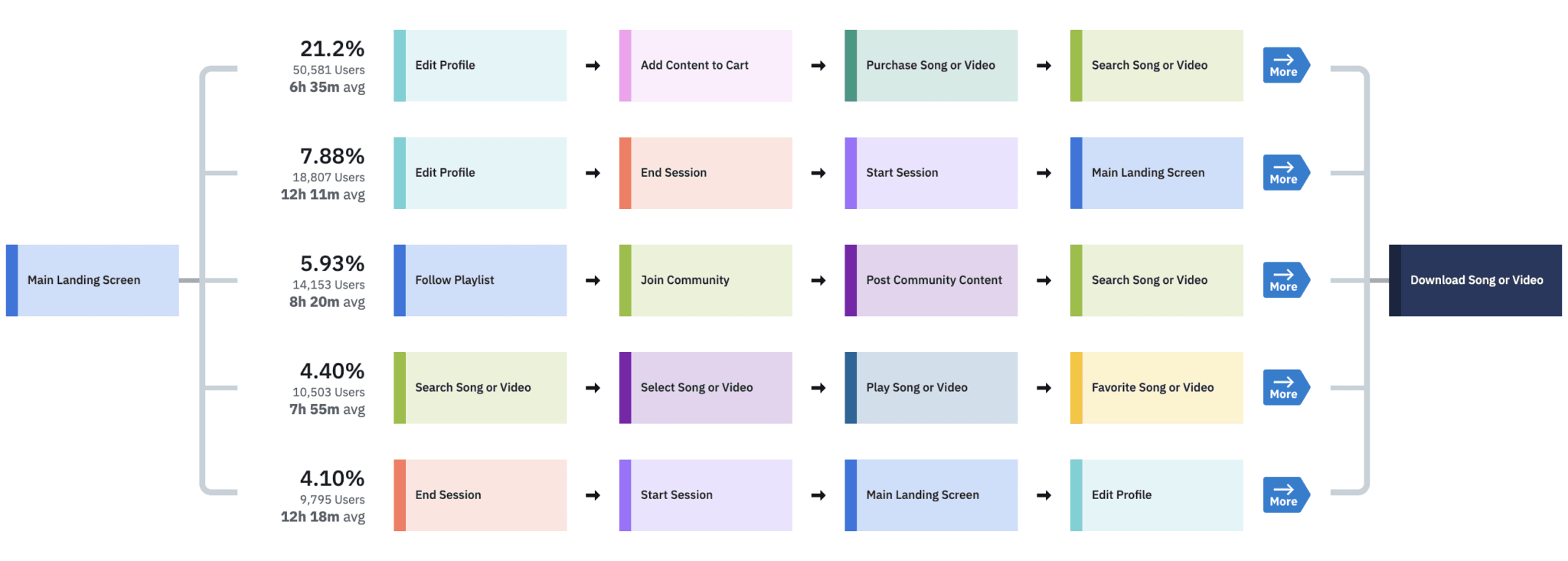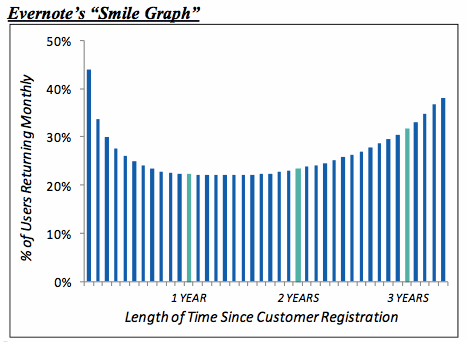4 User Insights Behavioral Analytics Can Give You
Why paying attention to consumer actions and preferences is critical to your business’s success.
Basic customer metrics like daily or monthly engagement are useful, but they don’t reveal what users really think about your product. Additionally, “vanity metrics” such as “likes, downloads, views” are not reliable long term, especially considering seasonality in customer preferences.
Although we can’t read a customer’s mind to find out what they want in a product, we can look to the next best thing—behaviors.
Behavioral analytics can help you understand what your prospects and customers actually find valuable because actions (even in the digital world) speak louder than words. Whenever they click a button, ignore a notification, create a wish list, or share a link, customers are giving you important data known as behavioral analytics.
What Is Behavioral Analytics?
Behavioral analytics is the process of categorizing and quantifying specific events or actions taken by prospects or customers: navigating a website, filling out a sign-up form, or adding items to a shopping cart. When someone performs one of these actions inside a digital environment, it communicates intent, motivation, or dislike.
This first-party data is generated directly from your customers—it provides an indispensable foundation of knowledge that far supersedes third-party demographic data. Things like age, location, and occupation can help your marketing team understand who your customers are, but they don’t tell you anything about how customers are interacting with what you’ve built.
Business intelligence starts at home with analytics that are directly given to you. As you build products, and communities of customers around those products, your own data will give your company a strong platform of knowledge about what’s working, what’s not, and how to make improvements.
How Behavioral Analytics Delivers Game-Changing Insights
It’s easy to say that behavioral analytics will give you new insights, but it can be hard to visualize exactly what those insights will be or how they’ll affect your business. Most businesses today are conscious of the importance of data but knowing how to interpret it and put it into action is half the battle.
1. Deeper Understanding of the Entire Customer Journey

How does a new prospect or existing customer interact with your website, app, AND product? For businesses with multiple digital touchpoints, analytics can give a complete picture of what the customer wants so you can craft goals that are coherent across your teams and platforms. We might call this a cross-platform multi-device user journey. Behavioral analytics gathers and makes sense of all this data: where customers come from, where they go, what they purchase, and how long they interact.
An example of analytics giving a complete view of user behavior across a company’s digital estate might look like this:
- A prospect interacts with an advertisement on social media
- They arrive on your site, and click on a CTA button to download your app
- After downloading, they log in to the app
- Profiles and avatars are created
- They watch a tutorial video
- They play your game
- They connect their address book to find friends
- When playing with friends, they choose to make an in-game purchase that offers them an advantage
- They send invites to other friends to play
So far, the prospect has made certain decisions across a digital ad, website, and mobile app. Once you have this information, you can follow the trends and preferences of your most loyal customers and tailor the super funnel accordingly. This is much better than paying attention to a certain metric because it sounds important. Behavioral analytics liberates you from vanity metrics and helps you focus on critical milestone moments. For instance, if your most long-term customers always share a certain link on Day 3, it’s probably worth your time to figure out new ways to incentivize other customers to follow that trend.
2. An Improved Product Experience
In today’s fast-paced digital market, brand loyalty means little in the face of high competition. To succeed, businesses need to offer standout digital experiences that communicate value and leave users satisfied. The best way to accomplish that goal is to prioritize an intimate understanding of prospects and their behaviors.
Once a product goes live, the question of how it is being used becomes urgent. Behavioral analytics allows teams to identify bottlenecks: why do people abandon shopping carts, quit sessions, or leave forms partially filled out? If you launch a new feature in your app, you need to know how users are finding it, what piques their curiosity, and what makes them want to come back to it. Give a customer exactly what they need, when they need it, and you’ll earn retention and loyalty.
As companies face constant disruption and tech innovation, a digital product is almost never considered “finished.” In fact, the entire nature and purpose of your business might change after you take notice of how customers end up using your product.
3. Increased Leads and Conversions
Behavioral analytics can be used to combine prospect and customer journeys so you can compare the results from different sources over time. Which websites, ads, or channels are sending you the most leads? Are certain search terms driving traffic?
Answering those questions is a start, but watching what prospects do after they convert will set a precedent for future prospect journeys. Over the days and weeks that follow, what kinds of customers do those different types of leads turn into? By following patterns of action and behavior, you can refine your prospect journey to mimic the digital footsteps of high-converting customers.
If your conversion rate is low and slow, then behavioral analytics can help you understand where prospects are jumping ship. Can you streamline the process or make conversion an option at a more convenient moment in the user’s journey? If potential customers aren’t signing up after a free trial period, use A/B testing to try different options and analyze the results. Simply extending the free trial may work, as opposed to a traditional email storm reminding them that time is up. If it does, now you have firm data that can be used to improve that specific section of the prospect experience.
For larger businesses, it’s important to share proven insights across teams to truly extract the most value out of the data. Using behavioral analytics to drive better leads and higher conversion isn’t just relevant to the marketing team. Cross-pollination with the product and sales teams only enriches the possibilities of improvement.
4. Subscriber Retention

If you walk by a restaurant and see a line forming outside the door, you might think, “that seems like a very successful restaurant.” What you don’t see are all the folks who ate once and never came back. Oftentimes getting excited about high conversion rates and early engagement can be distracting. The reasons why customers stick around are not always the same reasons why they came to you in the first place. Behavioral analytics empowers your business to know the difference, learn what’s working, and then do more of it.
Before you can increase retention, you need to understand what qualifies a customer who is retained. Certain milestones reached by long-term customers can be good indicators of retention. You might imagine these milestones as checkpoints that are native to your business, industry, and product. A mobile game might have a different retention expectation than a banking or shopping app. Behavioral analytics can help you track what kinds of users are coming back to different aspects of your product and when, what drives them back to you, and what triggers them to leave.
Perhaps your long-standing customers all connect your note-taking app to their Google Drive. If you can tailor the product experience to incentivize more Drive integrations, you have a better chance at fortifying retention. By using this form of retention analysis to narrow in on high-value customers, you can understand which events reveal the true value of your product so you can communicate it to everyone else.
The Best Feedback Is Behavior
The most successful companies understand that creating a digital product is a collaboration with the people who will pay to use it. Modern consumers actually expect this level of immediate alteration, and when it doesn’t happen, they’ll move on to the next option.
Customers are telling you a lot just by how they use your product. The most impactful insights about what your customers want and need are being generated right now as your customers make their way through your digital world. Behavioral analytics gives you the opportunity to tap into this wealth of information.
Continue your learning about behavioral analytics with the Mastering Retention playbook.

Darshil Gandhi
Director, Product Marketing, Amplitude
Darshil Gandhi is a Director of Product Marketing at Amplitude. He leads global technical and partner product marketing, collaborates with product and go-to-market teams on strategy, positioning, messaging, campaigns, and enablement. He was previously a solutions consulting team principal at Amplitude, and has helped dozens of Amplitude customers turn their data into actionable insights. Darshil graduated from Dartmouth College with a Masters in Engineering Management.
More from Darshil





